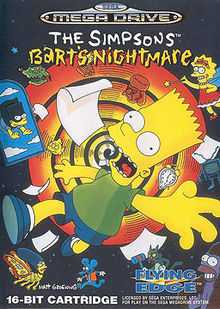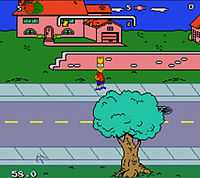The Simpsons: Bart's Nightmare
| Bart's Nightmare | |
|---|---|
 | |
| Developer(s) | Sculptured Software |
| Publisher(s) | Acclaim Entertainment (SNES) Flying Edge (GEN) |
| Platform(s) | SNES, Sega Genesis |
| Release date(s) | SNES NA September 1992 EU February 18, 1993 JP February 26, 1993 Sega Genesis |
| Genre(s) | Platform |
| Mode(s) | Single-player |
| Distribution | 8-megabit cartridge |
The Simpsons: Bart's Nightmare is a 1992 video game developed by American company Sculptured Software based on the television show The Simpsons. It was released on the SNES and the Sega Genesis.
Plot
Bart Simpson falls asleep while studying and wakes up in a strange universe where TVs and fairies roam the streets. The player must find Bart's lost homework and progress through the various levels to keep the homework pages and eventually return to reality.
Gameplay

The game is split in two parts. The first is set on a street (probably Evergreen Terrace, but referred to as Windy World). Bart walks around and has to find pages of his homework while avoiding enemies such as living post boxes and various characters from the show. Bart can collect his skateboard, which acts as a power-up and temporarily increases the player's speed as well as restoring and extending Bart's health bar the longer he is on the skateboard. Jimbo and his gang would coerce Bart into strolling with them, causing Bart to lose control of his movements and have to move with them, even having to take damage. Lisa Simpson with pixie wings would sprinkle fairy dust on Jimbo and his gang and transform them into rats, freeing Bart. However, if Bart is by himself, the Lisa pixie would turn him into a frog, where the frog Bart could not attack. If Bart caught a kiss blown to him by an old lady, it would revert him to his human form. Bart would also have to use bubblegum to blow a bubble to repel enemies as well as collect floating Zs to restore health.
Principal Skinner occasionally appears and tries to dress Bart in his Sunday school suit. If the player walks into Skinner, Bart will change appearance and become very slow and not be able to fire at enemies; however, the suit will also protect Bart from losing Z's from all enemies (save Jimbo and his gang).
When a page is found in Windy World, the player must jump onto it, where Bart will shrink down on the page, and the player has to choose one out of a selection of two randomly chosen mini-games. The player must point Bart to one of the two color-coded doors to play a mini-game and retrieve a lost page of Bart's homework. The doors and games are:
- The green door: Bartzilla, a two part mini-game where Bart must stomp through the streets of Springfield and destroy the army with fire breath and visual lasers. After being zapped by a shrink ray, Bart climbs the Springfield State Building and fights "Homer Kong" and "Momthra."
- The violet door: A journey into Bart's blood stream, where Bart must use an air pump to inflate and destroy germs. After collecting 5 atoms when the page is visible, the player wins. This mini-game has a cameo appearance from Smiling Joe Fission (a character from the first-season episode "Homer's Odyssey").
- The yellow door: Itchy and Scratchy, where Bart is being attacked by the "team up" duo, as well as various other household objects that become enemies (the oven shoots fire, the telephone explodes, Marge's picture drops eyeballs, Pyro-Vacuums etc.) All fire-based attacks are instantly fatal, with Bart crumbling to ashes. This is the only mini-game divided into two separate parts; Bart must locate another page in Windy World before playing the second mini-game.
- The blue door: Bartman, where Bart flies over Springfield as a superhero. Along the way he fights many bosses, including Sherri and Terri in a hot air balloon, Barney Gumble on a pink elephant, Waylon Smithers in a blimp (you face him twice), and eventually Mr. Burns in a biplane. Besides the enemies, Bart must avoid clouds of radioactive gas. Bart also receives soda bottles from Apu on a magic carpet in this level, which serve to raise his energy bar.
- The orange door: Indiana Bart, where Bart must make through the balancing columns in "Temple of Maggie". There are two stages, each with a page reward at the end.
The mini-games can be played in any order; the pages awarded will be 1 through 8 depending on the order they were retrieved.
Upon either losing all the lives in the respective mini-game (and not getting the page back) or completing the mini-game (and receiving the page as a reward), the screen will flash back to Bart's room at night, which shows the amount of points the player has and the number of pages collected, while Bart snores. Once a minigame is completed, it will not resurface later in the game. If there is only one mini-game left, both doors will be the same color.
The game ends when Bart loses all of his Zs (Windy World will be covered in a white fog, suggesting Bart is about to wake up) and takes damage one more time, or if he accomplishes all the mini-games. The first shot is a pic of Bart asleep at his desk in his room; if not all pages are recovered, Bart's homework will end in a scrawl, but recovering all pages will have the words "THE END" written on Bart's paper. Depending on how many mini-games Bart finishes and how many points he gets, he is awarded a letter grade. Bart will hold it up for the player to see, and then the different endings are shown where the players sees the Simpson family's reactions to Bart's grade by having the paper affixed to the refrigerator, which is strikingly similar to the final scene in Bart Gets an F. An "F" grade, the worst ending, would have the entire family upset and mad at him, but a slightly higher grade would cause at least Homer to be pleased with Bart's work. Lisa would be annoyed with Bart's work unless the player manages to get Bart an outstanding grade in which she will look at Bart's paper in disbelief.
This mini-game oriented gameplay gave the game an arcade style. Although much of the game could be categorized as platformer, some of the mini-games could fit in the shoot-em-up genre, particularly the Bartman and Bartzilla stages.
| Reception | ||||||||
|---|---|---|---|---|---|---|---|---|
| ||||||||
Production
Company meddling during the development of the game prompted Bill Williams, the game's designer, to leave the video game industry.[3]
References
- ↑ Mega rating, issue 20, page 65, May 1994
- ↑ "Bart's Nightmare Import Review".
- ↑ Reimer, Jeremy. "A history of the Amiga, part 7: Game on!". Ars Technica.
External links
| ||||||||||||||||||||||||||||